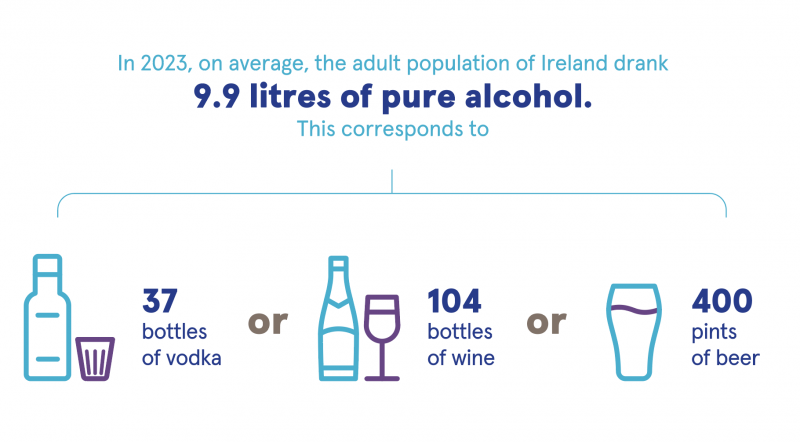Doyle, Anne  ORCID: https://orcid.org/0000-0002-2776-3476
(2024)
Alcohol: availability, affordability, related harm, and policy in Ireland.
Drugnet Ireland,
Issue 88, Summer 2024,
pp. 1-4.
ORCID: https://orcid.org/0000-0002-2776-3476
(2024)
Alcohol: availability, affordability, related harm, and policy in Ireland.
Drugnet Ireland,
Issue 88, Summer 2024,
pp. 1-4.
| Preview | Title | Contact |
|---|---|---|
|
PDF (Drugnet Ireland 88)
1MB |
Background
The Health Research Board (HRB) published its fifth alcohol overview in April 2024.1 Using data from published Irish and international literature and information systems and surveys, the report examines how much people drink in Ireland, trends over time, and the consequences of their alcohol use. This report also examined alcohol availability and affordability, two key drivers of alcohol use.
Alcohol use in Ireland
In 2023, per capita alcohol use per person aged 15 years and over in Ireland was 9.9 litres of pure alcohol, a decrease since 2022 (10.2 litres).
Patterns of alcohol use in Ireland
Survey data indicate that approximately one-half of drinkers in Ireland can be classified as hazardous drinkers, more common among males than females, and 32% of drinkers drink multiple times per week. There is a growing minority of young people choosing not to drink, from 18% in 2002 to 28.2% in 2019. However, it is important not to become complacent about alcohol use among young people as hazardous drinking is common in those that do drink.
Alcohol availability in Ireland
Despite an 8% decline in the number of pubs in Ireland since 2012, the country ranks third highest in the world for the number of pubs per 100,000 population. A geospatial analysis of the location of all licensed premises indicated that 73% of the population of Ireland live within 300 metres of a licensed premises and that they are more common in areas of higher deprivation.
Alcohol affordability and expenditure
Although the cost of alcohol in Ireland is the fourth highest in the European Union, in 2021, Ireland had the second most affordable alcohol of OECD (Organisation for Economic Co-operation and Development) members, and price increases have kept in line with inflation, meaning that alcohol remains as affordable now as it was in 2003. Irish households spent EUR 2.9 billion on off-trade alcohol in 2021, which is equivalent to 0.7% of Ireland’s gross domestic product.
Alcohol-related harm
To understand alcohol-related harm to health, the number of alcohol-related hospitalisations were examined. There were 18,877 discharges from Irish hospitals in 2021 that were wholly attributable to alcohol use, a 16% increase compared with 2001. However, when population increases are factored in (which have been substantial in that time period), it represents a 17.1% decrease per 100,000 population. However, alcohol-related liver disease has continued to rise, even when population increases are considered, with 2021 seeing the highest ever number of hospitalisations for the condition, increasing by 80% in the 20-year period.

Alcohol use and mental health
The association between alcohol use and suicide and self-harm incidents in Ireland is evident, as one-third of self-harm hospital presentations in 2020 involved alcohol use. A study in the Cork area found that alcohol was present in the toxicology reports of 44% of suicide cases.
Alcohol-related crime in Ireland
Data from the PULSE system (Police Using Leading Systems Effectively) indicated that there were 5,527 incidents of drink driving in 2022; some 9,917 incidents of ‘drunkenness’; and 237 liquor-licensing incidents.
Alcohol-related mortality in Ireland
The Global Burden of Disease (GBD) Study estimates that four people die in Ireland every day due to alcohol use and that alcohol use has risen from being the 13th leading cause of death in the population of Ireland in 1990 to the eighth leading cause of death in 2019.
Alcohol treatment
Data from the National Drug Treatment Reporting System (NDTRS) indicate that the number of cases receiving treatment for alcohol as the main problem drug decreased by 2.6% between 2015 and 2022. However, cases receiving treatment for cocaine as the main problem drug and alcohol as a secondary problem substance have increased substantially in the same time period. The most common treatment intervention received is brief intervention, followed by counselling and alcohol detoxification.
Alcohol policy in Ireland
The most important development in alcohol policy in Ireland in the last decade has been the enactment of the Public Health (Alcohol) Act in 2018. The legislation, based on the World Health Organization’s ‘best buys’ recommendations, sees alcohol as a public health issue. Most of the components of the Act have been commenced and, in May 2026, Ireland will be the first country globally to have such detailed and comprehensive labelling on alcohol products. The report also considers the proposed Sale of Alcohol Bill 2022.
Conclusion
Despite a recorded decline, Ireland continues to have a high level of per capita alcohol use that remains above the Department of Health’s reduction aim as well as the current Health Service Executive (HSE) low-risk drinking guidelines. The consequences of alcohol use in Ireland are outlined in the report, and future overviews will continue to observe alcohol use and related harms, providing evidence of any impact of legislation or policy changes.
1 Doyle A, Mongan D and Galvin B (2024) Alcohol: availability, affordability, related harm, and policy in Ireland. HRB Overview Series 13. Dublin: Health Research Board. Available from: https://www.drugsandalcohol.ie/40465/
A Substance use and dependence > Substance related societal (social) problems / harms
B Substances > Alcohol
L Social psychology and related concepts > Availability, accessibility, and supply
MP-MR Policy, planning, economics, work and social services > Economic aspects of substance use (cost / pricing)
VA Geographic area > Europe > Ireland
Repository Staff Only: item control page